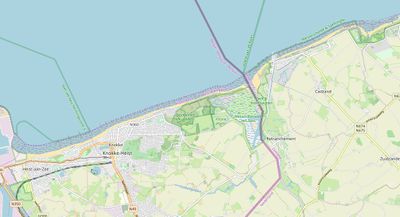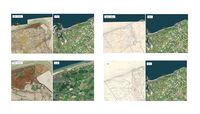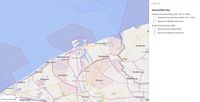COLAND Case Study 2020 - Knokke: Difference between revisions
Jump to navigation
Jump to search
Nuciu.maria (talk | contribs) |
Nuciu.maria (talk | contribs) |
||
| Line 44: | Line 44: | ||
*''The main human activities in the Belgian coast area include: extraction, maritime transport, fishing, industry and mining. All the activities have led to a degradation of the Belgian coast area, a qualitative and quantitative degradation of the coastal ecosystem. The managerial responsibility of governing the institutions is limited to the manifestation of state power from the federal, regional and local areas.'' | *''The main human activities in the Belgian coast area include: extraction, maritime transport, fishing, industry and mining. All the activities have led to a degradation of the Belgian coast area, a qualitative and quantitative degradation of the coastal ecosystem. The managerial responsibility of governing the institutions is limited to the manifestation of state power from the federal, regional and local areas.'' | ||
<gallery caption=" " widths="200px" heights="150px" perrow="5"> | <gallery caption=" " widths="200px" heights="150px" perrow="5"> | ||
File: | File:colandwiki.hfwu.de/images/8/82/B.G.png|''The geology of Belgium'' | ||
File:yourcase_landscapeunits2.jpg|''add a caption'' | File:yourcase_landscapeunits2.jpg|''add a caption'' | ||
</gallery> | </gallery> | ||
Revision as of 09:09, 20 February 2020
>>>back to working groups overview
Rationale
- Why do you think this case is relevant? What is your hypothesis considering the landscape challenges?
- Format: 3-4 sentences
Location and scope
You can edit this map with the map editor
A Landscape System Analysis
A.1 Landscape layers and their system context
Geomorphology, landscape units and coastal typology
- Belgium can be divided into three main geographical regions, such as: in the north-west a coastal plain area, a central plateau area and in the southeast a high plateau of the Ardennes.
- With a coastal area of approximately 98 kilometers, bordering the southeastern part of the North Sea, the influence of the sea is felt in the cities of Belgium that are now protected against flooding.Belgium has a very small coastal area, but it hosts several types of coastal habitats, which are important for the flora and fauna of the area, such as: underground sand banks, sandy beaches, intertidal sand dunes, sand dunes and polder meadows. The coastal area is constantly moving, a major factor is the erosion in the surface and the sedimentation processes, in addition to the human activities, which can have a positive and negative impact.
- From a geological point of view, the territory of Belgium comprises various typologies formed over millions of years, in the north being cenozoic deposits consisting mostly of marine and unconsolidated sediments, in the south, the Paleozoic rocks dominate on large areas.
- The main human activities in the Belgian coast area include: extraction, maritime transport, fishing, industry and mining. All the activities have led to a degradation of the Belgian coast area, a qualitative and quantitative degradation of the coastal ecosystem. The managerial responsibility of governing the institutions is limited to the manifestation of state power from the federal, regional and local areas.
- Colandwiki.hfwu.de/images/8/82/B.G.png
The geology of Belgium
- Yourcase landscapeunits2.jpg
add a caption
Land use
- settlements, infrastructure, agriculture, resource extraction, natural areas, energy production...
- description of evolution, status quo and driving forces, is the land use likely to change? Why is that? (approx 200 signs)
- add 1-2 graphical representations to the image gallery, you can add more if you like
Green/blue infrastructure
- What are the major potential elements of a green/blue infrastructure network? Are these likely to change/disappear? Why is that?
- You find my background material on green infrastructure in our reading list
- add 1-2 graphical representations to the image gallery, you can add more if you like
- Your case green blue infrastructure1.jpg
add a caption
- Your case green blue infrastructure2.jpg
add a caption
Actors and stakeholders
- Who is driving changes in this landscape? Who is affected by those changes?
- Draw a stakeholder and/or power map: Who is affected highly but with low power? Who has high power but is not affected?
- Your case your powermap.jpg
add a caption
Sacred spaces and heritage
- Which places/elements hold cultural value and to whom?
- You may add a map and some images, please also explain in your caption why these elements are valuable
- Your case sacredspace1.jpg
add a caption
- Your case sacredspace2.jpg
add a caption
- Your case sacredspace3.jpg
add a caption
Visual appearance and landscape narrative
- Knokke is known for its beautiful landscapes therefore is an inspiration for numerous artists to capture different aspects such as the magical dunes or windmills. Camille Pissarro is one of the artists that was mesmerized by this area, so he created in 1894 "The Dunes at Knokke" oil on Canvas, and "Windmill at Knokke", both paintings show the Impressionism style and highlight the mystical nature that surrounds Knokke.
- Your case character1.jpg
add a caption
- Your case character2.jpg
add a caption
- Your case character3.jpg
add a caption
A.2 Summary of your landscape system analysis and your development targets
- You can summarize your findings with an DPSI(R) Model or a Spider Diagram
- Link back to the Sustainable Development Goals: Which goals are at risk?
- What is your hypothesis for this landscape?
- Visualise your hypothesis with one graphic/pict
- Are there any existing initiatives taking action in this landscape? Do you have a critical perspective on that?
- Add text and visuals
- Your case your spider diagram or dpsir model.jpg
explain your analysis briefly in the caption
- Your case your hypothesis visual.jpg
explain your hypthesis briefly in the caption
A.3 Theory reflection
- Reflect on at least three international policy documents in relation to their local landscape case
- choose one international, one European and one national document
- You can choose references from our reading list
- Scope: 250 words
A.4 References
- give a full list of the references you have used for this section
Phase B: Landscape Evaluation and Assessment
B.1 Assessment Strategy
- Based on the hypothesis derived from your previous landscape systems analysis you are now asked to define the goals for assessing the landscape. Your assessment is the basis for evaluating the landscape status.
- Which elements and phenomena need to be mapped, why and how?
- This a text contribution, max 250 words
B.2 Mapping
- As defined by your assessment strategy you conduct the mapping and present your findings here
- As a minimum, at least three different themes need to be mapped, you may choose more if needed
- Your case your assessment mapping themel.jpg
briefly explain the findings of your mapping
- Your case your assessment mapping theme2.jpg
briefly explain the findings of your mapping
- Your case your assessment mapping theme3.jpg
briefly explain the findings of your mapping
B.3 Problem definition and priority setting
- Give a summary of the major findings of your mapping process, what are the problems/potentials identified?
- Draw a problems/potentials map
- Set priorities for the most relevant issues
- Your case problems potentials map.jpg
add caption here
B.4 Theory reflection
- Please reflect the assessment and evaluation methods used based on at least three readings
- Did you encounter limitations'
- 200 words test contribution
B.5 References
- give a full list of the references you have used for this section
Phase C – Strategy and Master Plan
C.1 Goal Setting
- Define strategic planning objectives based on the evaluation findings
- Link back to your original targets from section one and the Development Goals
- 150 words text contribution
C.2 Spatial Strategy and Transect
- translate your strategic goals into a vision
- develop a spatial translation of your vision
- exemplify your vision in the form of a transect with concrete interventions
- add map(s) and visualizations
- Your case spatial translaton vision.jpg
add caption here
- Your case transect.jpg
add caption here
- Your case transect detail1.jpg
add caption here
- Your case transect detail2.jpg
add caption here
C.3 From Theory of Change to Implementation
- For implementing your vision: Which partnerships are needed? Which governance model is required?
- Who needs to act and how? Draw and explain a change/process model/timeline
- Which resources are needed? On which assets can you build?
- add 150 words text and visuals
- Your case spatial your governance model.jpg
add caption here
- Your case spatial your process model.jpg
add caption here
C.4 References
- give a full list of the references you have used for this section
D. Process Reflection
- Reflect in your intercultural and interdisciplinary team on the outcomes of your study
- Which limitations were you facing?
- What have you learnt from each other?
- What would you do differently next time?
- You can also use diagrams/visuals
- 250 words text



